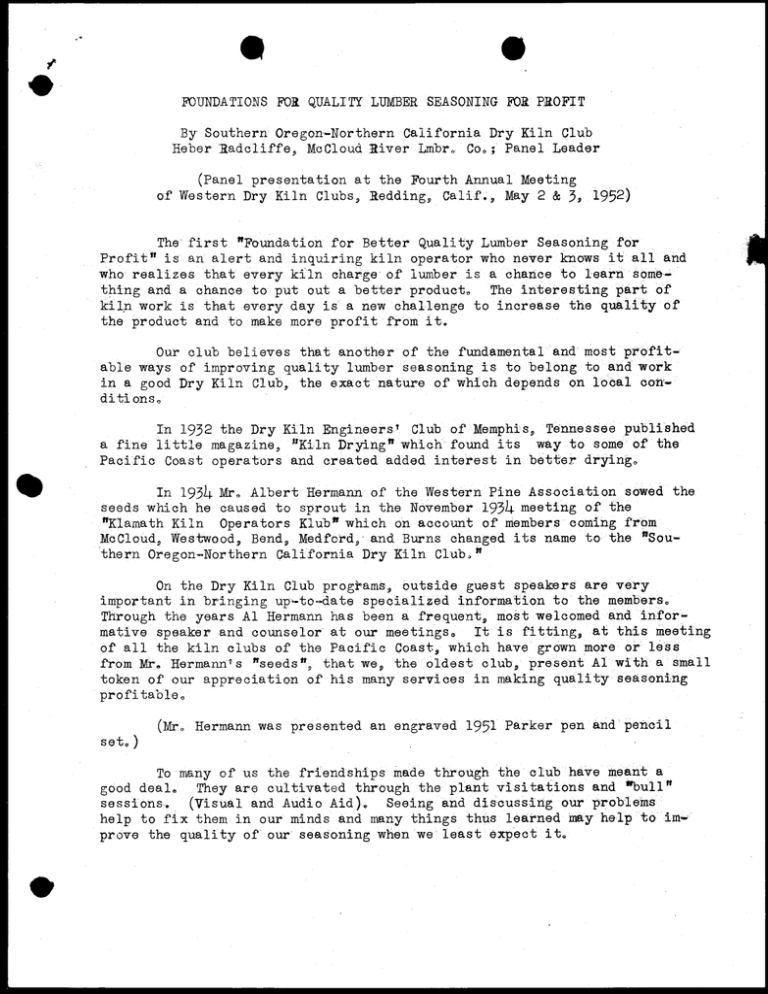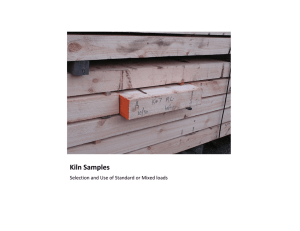•
advertisement

• FOUNDATIONS FOR QUALITY LUMBER SEASONING FOR PROFIT By. Southern Oregon-Northern California Dry Kiln Club Heber Radcliffe, McCloud River Lmbr. Co.; Panel Leader (Panel presentation at the Fourth Annual Meeting of Western Dry Kiln Clubs, Redding, Calif., May 2 & 3, 1952) The first "Foundation for Better Quality Lumber Seasoning for Profit" is an alert and inquiring kiln operator who never knows it all and who realizes that every kiln charge of lumber is a chance to learn something and a chance to put out a better product, The interesting part of kiln work is that every day is a new challenge to increase the quality of the product and to make more profit from it. Our club believes that another of the fundamental and most profitable ways of improving quality lumber seasoning is to belong to and work in a good Dry Kiln Club, the exact nature of which depends on local conditions. In 1932 the Dry Kiln Engineers' Club of Memphis, Tennessee published a fine little magazine, "Kiln Drying" which found its way to some of the Pacific Coast operators and created added interest in better drying. In 1934 Mr, Albert Hermann of the Western Pine Association sowed the seeds which he caused to sprout in the November 1934 meeting of the "Klamath Kiln Operators Klub" which on account of members coming from McCloud, Westwood, Bend, Medford, and Burns changed its name to the "So u them Oregon-Northern California Dry Kiln Club." On the Dry Kiln Club programs, outside guest speakers are very important in bringing up-to-date specialized information to the members. Through the years Al Hermann has been a frequent, most welcomed and informative speaker and counselor at our meetings. It is fitting, at this meeting of all the kiln clubs of the Pacific Coast, which have grown more or less from Mr. Hermann's "seeds", that we, the oldest club, present Al with a small token of our appreciation of his many services in making quality seasoning profitable. (Mr. Hermann was presented an engraved 1951 Parker pen and pencil set.) To many of us the friendships made through the club have meant a good deal. They are cultivated through the plant visitations and "bull" sessions. (Visual and Audio Aid), Seeing and discussing our problems help to fix them in our minds and many things thus learned may help to improve the quality of our seasoning when we least expect it, • Our problem for the next few minutes is a discussion or rather, from lack of time, some statements concerning profits made from better sorting and stacking for quality lumber seasoning. At one of our club's first meetings, our Chairman, the late Archie Kehoe, gave a detailed report on tests by one large company with edged stacked lumber. Several kiln charges of six quarter shop and better lumber were carefully graded, marked, tallied, stacked, dried, and regraded and tallied. Itemized values were figured and the netlloss from downgrade computed. Similar charges were checked and it was found that by increasing the number of sticks per course by two and by using heavier springs in their "take-ups" the lessened downgrade in the shop lumber alone for their operation in a year's time would result in a saving or profit of $45,000. Good sorting and stacking are important foundations of good kiln drying. Every mill, small or large, has or has had a sorting or stacking problem, the solution of which means more profit and better quality lumber. Mr. Hickman, can you think of such a problem? (Mr. Lyle Hickman, Palmerton Lumber Company, Klamath Falls, Oregon) We are using flat ataoking and here as elsewhere the foundations of better drying and more profits is better sorting and stacking. We have saved money by using a semi-automatic stacker and by using care in the stacking. Recently our company has been drying a lot of Philippine Mahogany and in order to prevent loss through warp and twist we have used stickers on eighteen inch centers. Well stacked cribs, with stickers in line, and careful drying have resulted in a high quality product which is developing an expanding market. The wood is beautiful but demands careful drying due to the interlocking and twisted fibers which are responsible for the many wonder ful figures in the grain. There are many operations which may not need stickers on such close centers but which could improve their product and their profits by using more sticks and by lining them up better. • Mr. Hubert Hamilton, (The McCloud River Lumber Company, McCloud, Calif.) will you present some problems, the solution of which resulted in profit and better quality seasoning? Mr. Hamilton: Our operation uses edge or vertical stacking and while our problems may not be the same as in many other plants; they may present some useful ideas. Some years ago we were troubled with spring take-ups which had lost their tension and this resulted in a weak take-up. This caused excessive warp and twist and much loss through broken and down-graded lumber. We devised a set of scales for checking the spring tension • and thus were able to eliminate all the weak springs. This resulted in improved quality and a nice profit. At one time we had trouble with the size of our crib loads-. They were so wide that they tipped up while being stacked and caused much lost time in labor. Then in drying the wide loads blocked the air passages and cut down the circulation through the load. This was especially bad with heavy stock. The decreased circulation resulted in uneven drying with much wet lumber and some warp and twist. By careful checking we found the cause of the trouble was the wide load and we corrected it by cutting down the width of the bunks, thus eliminating the restriction and evening the circulation through the load. This resulted in considerable profit to the company® In your operations, changes in size, shape or arrangement of your crib loads may make better quality seasoning and more profits. Mr. Orland Lynch, Weyerhaeuser Timber Company, Klamath Falls, Oregon; your operation has extensive sorting and stacking facilities which are the result of considerable study and experiment. Mr. Lynch: Better sorting and stacking play an important part in our plant at Klamath Falls. Our mill cuts about eight hundred thousand feet in two eight hour shifts. There are four principal species: Ponderosa Pine, Sugar Pine, Douglas Fir and White Fir with at times some western White Pine, Incense Cedar, and true Red Fir. Everything goes to the kilns. Our green chain is about 510 feet long and has 203 sorting pockets. This enables us not only to sort for thickness and species but also to sort to not more than two lengths to the crib. Some lengths are kept entirely separate. This helps to keep our. lumber straight. All stickers are kept in line and the end sticks are as close as possible to the ends of the boards. Stickers are cut green one inch full in thickness by two inches in width and shrink to 15/16 inch in thickness. We use six stickers per course in the sixteen foot cribs and five sticks in the twelve foot cribs. • We make a saving in drying time and quality by sorting to green moisture content in some stock. Take for example, our four quarter Ponderosa Pine Common which we wish to dry uniformly to 13 par cent final moisture content. The green nail heart or light" separation runs from forty to seventy per cent moisture content. The wmediumff 'covers from seventy to one hundred and fifty per cent while the "heavy or all sap" runs from that up to two hundred and fifty per cent. We dry the "light" to 13 per cent in thirteen to fifteen hours; the medium in from twenty-two to twenty-four hours; and-the heavy in fortyfive hours. This results in a real saving of drying time and money and in a much better quality of product compared to the general practise of mixed stacking and drying around thirty-six hours with a much too dry heart lumber and perhaps some wet sap. Even separation of light and heavy stock would result in much improvement. With this product a few hours overdrying can result in a decided loss. Panel Leader: Thank you, Mr. Lynch. After looking at several of the local mills, we wish to congratulate the lumber stackers of the B & D Lumber Company and Mr. Coy Brown on an exceptionally good job of hand stacking. We know it will produce a profit from better seasoning. Thank you. •



